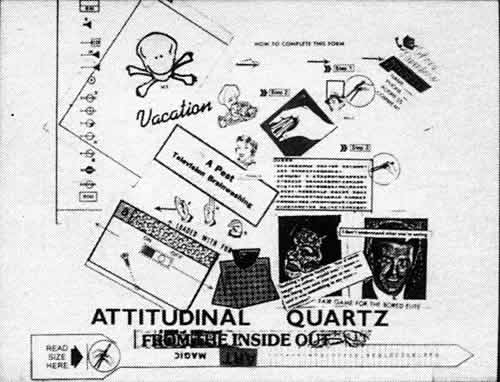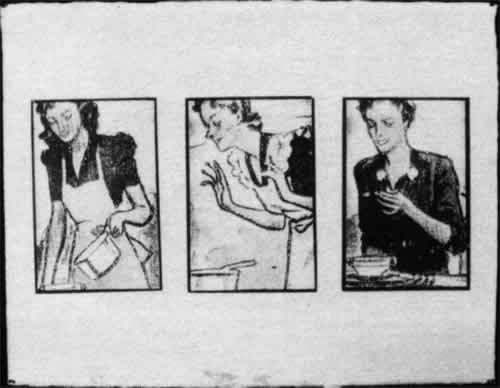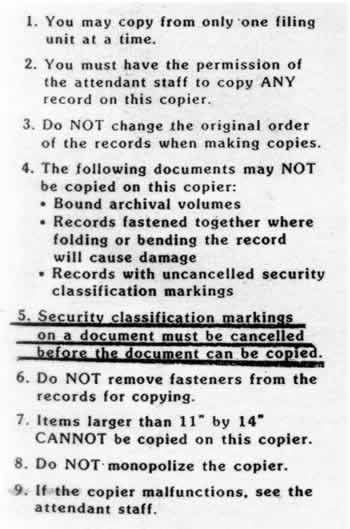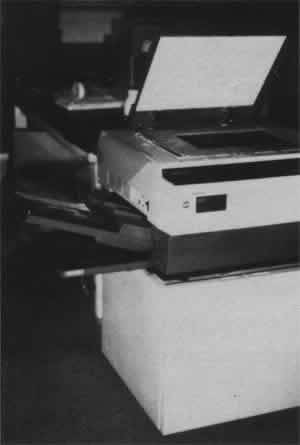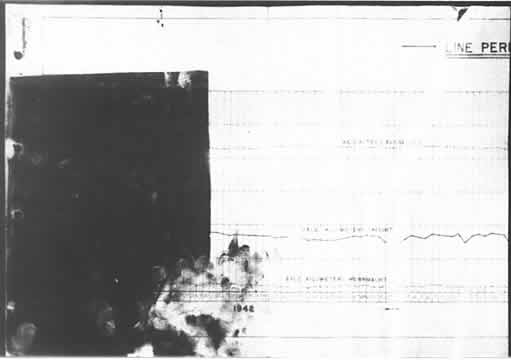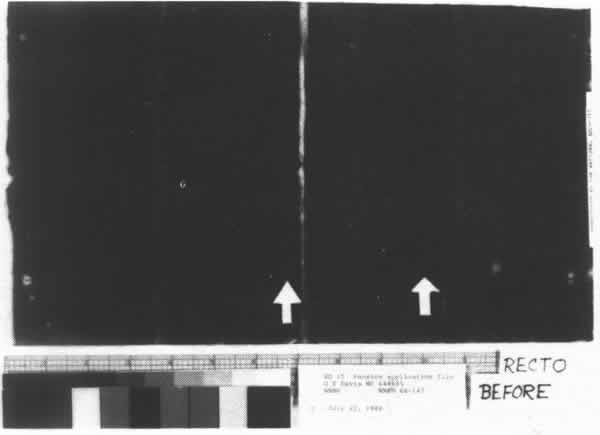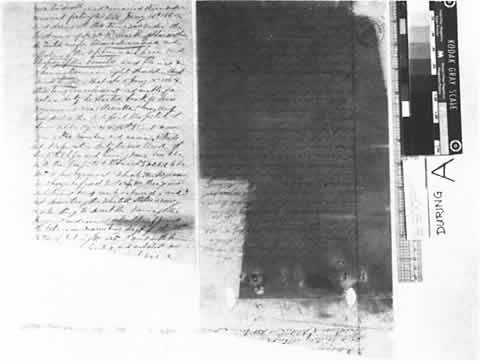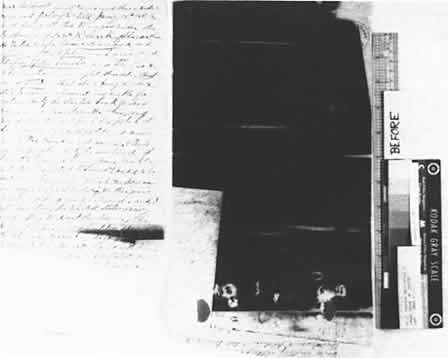Photocopier Hazards and a Conservation Case Study
By Kitty NicholsonIntroduction
The technology of electrostatic photocopying has transformed the intellectual transmission of information and knowledge in our lifetime. Inventor Chester Carlson unsuccessfully tried to market his invention between 1939 and 1944 to mare than 20 companies. Finally, Haloid, a small company in Rochester, New York, was willing to devote years to developing the first automated dry copier process. The first commercial use of Carlson's invention was Haloid's Xerox copier of 1950, a nonautomated imaging system with all process steps carried out by hand. When the machine became a success, the company changed its name to Xerox, based on the coined word "xerography" from the Greek roots for "dry" and "writing". The first fully automated Xerox 914 machine was shipped in 1960 (1). The Xerox machine made copies on plain paper and quickly gained market share in competition with Electrofax type copiers, introduced in 1954 by RCA, which produced electrostatic copies on a coated paper (2).
In 1960, an estimated 70 million copies were made. Twenty-five years later an estimated 500 billion copies were made (3). These figures mean, among other things, that more of the papers which people will choose to save in coming years will be photocopies.
The impact of the photocopier is not just in archival and library collections. Artists too have discovered the almost instantaneous images of the photocopier. In the early 1960's some of the first American artists began to use photocopies (4). The possibilities for artists are many. Photocopies can be used as collage elements. Solvents will transfer copier images to other surfaces including the lithographic stone. Artists' papers of reasonable weight, such as Strathmore charcoal paper, can be run through the machine, if cut precisely (Fig. 1). If the paper will not go through the feed, the image can be transferred onto the desired paper or other support (textiles, etc.,) using a specially-coated heat transfer paper (Fig. 2). One of the landmark exhibitions of photocopier art was the Electroworks exhibition, sponsored by the Xerox Corporation, which was displayed at the International Museum of Photography at George Eastman House and the Cooper-Hewitt Museum in 1980.
Electrostatic photocopies fall into two types. Xerographic or plain paper copies are indirect electrostatic copies, made using an intermediate photoconductive surface, such as a selenium drum or a photoconductive belt. The charged photoconductive surface receives the light reflected off the original and loses charge where struck by the light, creating a charged latent image that can attract toner particles. The resulting toner image is then transferred onto paper and fused with heat and/or pressure. (When xerographic copies are made on transparent films, the toner is generally fused by exposure to solvent vapors.) Copies made with zinc oxide coated paper, as in the Electrofax process, are direct electrostatic copies, in that the zinc oxide in a resin binder is the photoconductive surface which is charged and then receives the light reflected off the original.
In direct electrostatic copies, the toner can be applied as a dry powder or suspended in a solvent such as a hydrocarbon or halogenated hydrocarbon. Direct electrostatic copies made by fluid development give better tonal reproduction, but are low contrast images in which black appears as dark gray. Xerographic copies are high contrast with generally poor rendition of intermediate tones. In xerographic copies, the toner is applied as a dry powder. Some dry toner systems are monocomponent, but many are dual component systems, requiring the addition of toner and a so-called carrier. The carrier powder consists of fine spheres of sand, glass, steel, etc., which are not intended to become part of the final toner image, but act as a reusable physical aid in dispersing the toner particles evenly over the latent image (5). In both types of electrostatic copies, the toner image consists chiefly of carbon black pigment in a resin binder, though some dyes and other additives may be present.
The advent of color copiers greatly expanded the appeal of copiers to artists. In the late 1950's, colored toners were used experimentally with Electrofax copiers, and Haloid made seven color copiers for the Disney Studios which were used to create the animation cels for "One Hundred and One Dalmatians." Color copiers are used extensively today to create television cartoons (6). The 3M Color-in-Color photocopier was introduced in 1968, and in 1973 the Xerox 6500 Color Copier became available (7). Other companies such as Canon are now producing color copiers. Perhaps the most widely used at present is Canon's four color laser copier, introduced ca. 1986. An electrostatic copier, it uses a laser beam to create a digital image signal. The copy produced consists of powder toners heat-fused to a plain paper. The four colors are cyan, magenta, yellow, and black, so the copier can render a true black.
Because the peak of artists' use of photocopiers coincided with the period during which the Xerox 6500 and 3M Color-in-Color copiers were widely available, it is worth noting how to recognize these two processes. The Xerox 6500 is an electrostatic photocopier using a dry powder development process similar to the conventional Xerox copiers, except that the original is exposed through three color filters to activate magnetic brush development of cyan, magenta, and yellow toner colors (8). Xerox 6500 color copies have sharp boundaries, a characteristic raised relief and high gloss in the color areas. Often two or three broad bands of color will run the entire length of the machine direction, caused by a machine "dirty" with toner accumulation. There is similarly a fine striated texture parallel to the machine direction, apparently the tracks of the toner magnetic brush development. Artists found that the same sheet could be put through a Xerox color copier repeatedly to build up the thickness of the color layers, though at increased risk of having the sheet ignite.
The 3M Color-in-Color process is not an electrostatic copier process, but instead a heat-activated process in which infrared radiation causes dyes to be transferred onto a paper support (9). It is characterized by a matte, diffuse image with soft boundaries on a specially coated paper. It is memorable for being an unstable medium, as the colored dyes that make up the images remain heat sensitive. Apparently the dyes are quite volatile and diffuse out of the image onto adjacent surfaces over time. Color-in-Color copies require cold storage and special interleaving to minimize dye transfer and migration (10).
Conservators should be aware that there are preservation problems associated with some types of photocopies, though generally non-electrostatic copies present far more problems than electrostatic copies. William Hawken compiled a detailed survey on the large number of copying systems that were known in the 1960's (11). Stability problems are of three types: unstable images, unstable supports, and poor adhesion between image and support. Black electrostatic copier toner is essentially a mixture of finely ground carbon black in one or more synthetic resins, often a styrene/acrylate copolymer. Since carbon black is quite stable and permanent, the stability of the resin binder is the limiting factor. The various color toners may be based on colored dyes or pigments of widely varying light stability and permanence in synthetic binders. Experience suggests that the paper used in so-called plain paper copiers is more durable and less prone to scuffing and burnishing than the coated paper stocks used in direct electrostatic copiers. The paper coating is also vulnerable to cracking when folded. Since zinc oxide is a known photosensitizer of cellulose, it is to be expected that direct electrostatic copies will show greater instability on exposure to light. Toner adhesion in direct electrostatic copies is a function of heat or solvent evaporation. Generally, the toner penetrates the coated surface giving good adhesion. The adhesion between a xerographic image and support depends on adequate heat and/or pressure for fusion of the low-melting thermoplastic resins used as binders. Malfunctioning or poorly adjusted equipment may not give adequate fusion. The Government Printing Office, under contract to the National Archives, has devised a test for satisfactory toner adhesion. They have also found indications that acrylic and styrene components extracted from toner are vulnerable to ultraviolet radiation, acidity and oxidizing fumes (12).
Electrostatic copies should be stored at moderate temperature and relative humidity. Because the resin binders are thermoplastic polymers with low softening temperatures, avoid storage under conditions of heat and/or pressure. Experience has shown that the binder resins in xerographic copies are vulnerable to blocking to adjacent surfaces with heat or pressure. Contact with polyvinyl chloride plastic can cause softening and transfer to adjacent surfaces because of plasticizer migration from the plastic. Light exposure during exhibition should be restricted, especially for dye-based copies such as Color-in-Color as well as for copies on zinc oxide coated paper. Xerox 6500 color copies appear to have a fairly good light stability. Black xerographic copies can be expected to have good to excellent light stability, depending on the quality of the paper support.
Conservation Case Studies
Recently, a relatively uncommon form of damage occurred at the National Archives in which historic documents fell into the copier's paper feed and were pulled into the machine. One document was retrieved before the toner was fused. In two other instances, toner was fused into a dense black layer over the text of the document, because the platen cover was raised at the time of copying.
When unfortunate accidents occur, it is useful to examine the circumstances to see how the event came to happen and how it might be prevented. All three accidents occurred when researchers were copying large groups of documents in a room for high-volume self-service photocopying. Because of limited staff and great demand for photocopies, the National Archives management allows the public to do their own copying, after materials are reviewed by staff. When feasible, limiting or prohibiting the public from copying original historic material would reduce, though not eliminate, the chance of damaging records. There are National Archives guidelines prohibiting self-service copying of bound volumes and oversized or fragile documents (Fig. 3). All three damaged documents were oversized (i.e. larger than exposure to light. Toner adhesion in direct electrostatic copies is a function of heat or solvent evaporation. Generally, the toner penetrates the coated surface giving good adhesion. The adhesion between a xerographic image and support depends on adequate heat and/or pressure for fusion of the low-melting thermoplastic resins used as binders. Malfunctioning or poorly adjusted equipment may not give adequate fusion. The Government Printing Office, under contract to the National Archives, has devised a test for satisfactory toner adhesion. They have also found indications that acrylic and styrene components extracted from toner are vulnerable to ultraviolet radiation, acidity and oxidizing fumes (12).
Fig. 1 and 2. Jan Mehn Von der Golz, "Attitudinal Quartz," color Xerox on charcoal paper, 1982, and "Soup Line," color electrostatic transfer on kochi paper, 1982.
Fig. 3. Copier guidelines of the National Archives.
Fig. 4. Copier with polyester guard draped over the paper feed.
Fig. 5. Diazo print with powder toner, before.
Fig. 6. Diazo print, after.
Fig. 7 (left) Davis pension application, before. Arrows indicate solvent tests.
Fig. 8 (right) Davis application after.
Fig. 9 (left) Racey pension application, before.
Fig. 10 (right) Racey application after solvent treatment and dry cleaning reserve areas.
Electrostatic copies should be stored at moderate temperature and relative humidity. Because the resin binders are thermoplastic polymers with low softening temperatures, avoid storage under conditions of heat and/or pressure. Experience has shown that the binder resins in xerographic copies are vulnerable to blocking to adjacent surfaces with heat or pressure. Contact with polyvinyl chloride plastic can cause softening and transfer to adjacent surfaces because of plasticizer migration from the plastic. Light exposure during exhibition should be restricted, especially for dye-based copies such as Color-in-Color as well as for copies on zinc oxide coated paper. Xerox 6500 color copies appear to have a fairly good light stability. Black xerographic copies can be expected to have good to excellent light stability, depending on the quality of the paper support.
The accidents all occurred on one copier model with a sloping paper feed on the left side. When an oversized document dangled over the left edge, it was perilously close to the paper feed. A simple modification was made on the copier by attaching a polyester film guard that draped down from the platen edge over the paper feed (Fig. 4). No further instances of damage occurred in the interval until a new copier model was installed in which the paper feed is inside the machine, totally inaccessible to dangling documents.
It is useful to consider these cases of extreme damage that have occurred in two years to the number of copies made annually in the self-service copy room. In fiscal year 1988, two photocopy machines were in almost constant operation, making a total of 451,486 copies. While the instances of extreme damage are relatively few, there are certainly many other documents that suffer physical damage: minor or major tears or other wear that is less dramatic or noticeable.
The document with unfused toner was an oversized diazo print, treated by a colleague. The toner could readily be removed by dry cleaning with Mars plastic eraser, eraser crumb and a soft brush (Fig. 5 and 6). The two documents with fused toner unfortunately could not be dealt with as expeditiously. The fused toner was an almost continuous glossy black layer which completely obscured the underlying pen and ink text (Fig. 7 and 9). Black toner takes its color from carbon black which has excellent covering power. If a typical photocopied page of text has about 25 mg of toner (13), then the affected sheets had easily at least 4 times more toner. The ingredients present in the toner layer were helpfully listed on the label of the Minolta MT Toner II (for EP 450-EP 4502 models): styrene acrylate copolymer, polypropylene, carbon black 1333-86-4, pigment, and copper oxide. While relative quantities were not given, they are probably close to typical toner compositions of 5-10% carbon black in 90 to 95 %o resin(s) (14).
There were fortunately a large number of paper offcuts from the culprit copier on which to test toner removal. Initial ideas included trying a tacking iron to apply heat and pressure from the back which resulted in a moderate transfer., but the remainder only became more strongly fused. Long contact with plasticized vinyl sheeting again only removed a small amount of toner. Solvent removal seemed most promising. The toner resin was readily soluble in several solvents, in fact too readily soluble. Repeated solvent applications on the suction table caused uneven removal, with cleaner areas surrounded by rings and lines of redeposited carbon particles. It quickly became evident that one or more soluble blue to purple dyes were also present.
The first document to be treated presented a challenge for solvent treatment, because the media present included not only pen and ink, and printer's ink, but also purple typewriter ink which was very soluble in water, heptane, ethanol, acetone, and methyl ethyl ketone. There were however two solvents which did not affect the purple but did show strong solvent action on the resin binder of the toner, toluene and ethyl acetate. To confirm lack of solubility, these last two solvents were retested by saturating small blotter squares with the solvent and applying them over purple media, covered with polyester film to retard evaporation and weighted for good contact. There was no sign of purple bleeding with either solvent, and the area saturated with toluene showed more offset of toner and a sharper boundary line of redeposited binder, compared to the area treated with ethyl acetate.
The rapid dissolving of the toner binder made it important to quickly and evenly immerse the object in solvent and then pull away the dissolved resin and as much carbon and dye as possible. Because the very fine carbon particles tended to redeposit and imbed in the pores of the paper, the suction table was used to pull carbon black and dissolved dye and resin out of the document. The document was immersed in a polyester tray of toluene for ca 5 seconds and immediately transferred face down on the suction table. The document edges were not covered until solvent had evaporated at the edges of the sheet. The sheet was slightly out of plane and the toner layer remained heavy in the area where the sheet was out of contact with the underlying blotter. The sheet was dipped in a fresh tray of toluene and transferred again to the suction table onto fresh blotter. The solvent immersions were repeated two more times, with only very slight transfer of carbon and dye on the suction table. At the conclusion of solvent immersions, the sheet had a gray haze of carbon imbedded overall in the areas previously obscured by toner and the text was once again legible (Fig. 8).
It is somewhat comforting to know that photocopies are a special challenge for the recycling industry because the toner particles are so difficult to remove. A patented process has just been published this year for a method using an unidentified proprietary solution that allows successful removal of toner in repulping (15).
During suction table work, a sheet of Whatman filter paper lay beneath the document, and two layers of blotter under the filter paper. In examining the layers after treatment, one could see the extreme mobility of the toner components. The first solvent immersion created a very heavy toner deposit on the filter paper and a large quantity of the carbon black moved through the filter to the first blotter. A pink dye component moved to and through the second blotter. On the second and third solvent immersions, a very slight blue and pink dye moved through the first blotter. A crude chromatographic separation of the dyes in the dissolved toner showed that pink and yellow dyes were present.
Because the gray haze of carbon remained, dry cleaning with Magic Rub vinyl eraser was tested on pen and ink writing and toner stained paper. While erasing slightly reduced the paper grayness, sufficient toner remained imbedded in the fibers to minimize overall improvement in the paper's brightness. In addition, the erasing appeared to diminish slightly the contrast of ink to paper. The only area in which dry cleaning was attempted was around the platen caption line which was an artifact of the copying accident and legible in the bottom margin of the document. (See discussion below concerning caption line which appears on National Archives copy machines.)
While this technique of toluene immersion and suction table extraction worked reasonably well from the standpoint of the document, the conservator was overexposed to toluene vapors, despite wearing gloves and a face mask with solvent cartridges and using a fumehood next to the suction table. When the next treatment of this type was planned, a plexi dome was placed over the suction table to contain solvent vapors and immersion was carried out in polyester trays on the top of the suction table.
The second document which had toner fused to the text surface had been pulled into the copier on the diagonal (Fig. 9). Apparently when the researcher realized what was happening, he or she grabbed the free end and thereby kept the second half from going through by virtue of tearing it off on the diagonal. It should be noted that both of the unfortunate documents were in a format which could be described as double legal folio with the fold at the top. The first document treated apparently was also torn in half, but along the fold rather than through the text. Because of the diagonal orientation through the machine, the second document had been crumpled, and torn a little along the edges, an aspect which became a factor in its treatment.
The media present on the second document were less problematic, no purple inks, just pen and ink, blue, red and graphite pencil notations, and a blue Pension Office stamp. The paper support was a blue-lined ledger paper with a pink margin line along the left edge. Spot testing showed no movement of any media in acetone, ethyl acetate, or toluene. In spot testing, the toner seemed to be most readily soluble in ethyl acetate, next most soluble in toluene, and soluble in acetone but not as well as in the previous solvents.
From the first treatment, it was clear that the document should be humidified and flattened prior to solvent treatment in order to get the best possible contact on the suction table for toner removal. A few small misaligned flaps had toner on the reverse of the flap, so they were left misaligned to keep all the toner on one side of the document during suction table work. Because ethyl acetate seemed to work at least as well as toluene in spot testing and because it had less unpleasant side effects on the conservator, it was chosen as the immersion solvent for this treatment.
The treatment was carried out under the plexi dome on the suction table with polyester trays of ethyl acetate for immersion. On the first immersion, the release of toner in small swirls was noted before the document could be lifted out and over to the blotter surface. Perhaps the solvent simply acted faster than toluene or the inconvenience of reaching in through portholes to transfer the document from the tray to the blotter made for slightly slower movement. The document was reimmersed in two further fresh baths of ethyl acetate and the surface was gently brushed with a natural bristle brush with an unpainted handle in an effort to dislodge imbedded carbon black.
While the brushing had a minor effect in removing carbon, the appearance of the toner covered areas after treatment was quite comparable to the document immersed in toluene. On the second document, there were substantial areas of paper bare of toner. After solvent treatment, it seemed that there had been some slight redistribution and redepositing of toner, especially along tear edges and along the broken and abraded paper in the top fold line. The redistributed carbon black could be substantially reduced though not completely removed, by dry cleaning with Magic Rub eraser stick. It probably would be advisable to mend or presize all tear edges and broken paper surfaces with a sizing agent such as methyl cellulose solution to prevent redeposition of carbon black into those areas (Fig. 10)
In examining the blotter surface after the first suction table extraction, a pale pink offset of the pink margin line could clearly be seen. While there was no fuzziness or bleeding of the dye around the pink line itself, some solubility existed which was not seen in spot testing. In addition on the verso some transparent solvent lines were visible, apparently related to the time interval between actual solubilization of the toner and the suction table extraction. The solvent lines may consist of resin or of some plasticizer but attempts to reduce them on the suction table were not successful.
Photocopying Hazards
This discussion of photocopying hazards will discuss hazards from diverse perspectives, first, that of damage to the paper object being copied, and then, the potential for harm to adjacent art or artifacts and to persons in the vicinity of the photocopier from chemicals and gases associated with photocopier operation. The term "photocopying hazards" brings to mind such common problems as the difficulty of copying books without damage, high light and heat levels at the copier platen, and everyday wear and tear on the originals being handled. Many of these concerns can be quickly and easily addressed. Photocopiers specially designed for the safe copying of tight bindings are now reaching the marketplace. While not yet widely available, hopefully they will be soon. The concern about high light and heat levels is tempered today by the knowledge that the time of exposure is very brief, so that cumulative light and heat are not great, as long as the item is not copied repeatedly (16). It is worth noting that some of the more sophisticated copiers which can adjust automatically for contrast, misalignment, etc., actually scan each page two or three times, increasing the light and heat exposure accordingly. Use of the nonautomated mode will reduce light exposure considerably.
Ultraviolet exposure does remain a concern. In the early days of photocopiers, the sensitizing light source was filtered green to match the optimal sensitivity of the photoconductive surface. This filtering conveniently removed all ultraviolet (17). Today a variety of light sources may be used. As glass transmits ultraviolet rays between 325 and 400 nanometers, copiers with ultraviolet-producing lights such as fluorescent, tungsten halogen or xenon flash will expose documents to some ultraviolet (18).
When an original item is liable to be copied repeatedly, a single master copy can be used (and retained) to make further photocopies, in order to prevent wear and tear and excessive light exposure to the original. Compiling and enforcing simple user guidelines for photocopying can minimize problems of copying materials whose physical format or condition do not readily permit safe copying. An obvious but often unstated guideline is that some items simply cannot be photocopied safely and staff must exercise judgment and authority in those cases'.
A seemingly minor problem related to photocopier use is confusing a photocopy for its original. The confusion may be accidental, as when a researcher carelessly annotates the original, thinking it. Is the photocopy; or it may be a deliberate ploy to purloin the originals, leaving copies in the folder or box returned to storage. A way to prevent this problem is to tape an identifying caption face down on an edge of the photocopier platen, so all photocopies made are captioned. All photocopiers in the National Archives that are accessible to the public have a platen caption "REPRODUCED AT THE NATIONAL ARCHIVES," based on the recommendations of the Holdings Maintenance Committee.
Pollutants and Hazardous Contaminants
The electrostatic photocopier works by generating a strong electrical charge on a photoreceptor surface. The charge is made by a corona discharge device called a corotron. It is well known in the photocopy industry that corotron charging devices generate both ozone and nitrous oxides from the reaction of charged ions and electrons with atmospheric gases (19). These gases can be hazardous to machine operators, as well as to media and paper and to the machines themselves, so there is active research in determining ways to reduce their levels. In addition, some photocopiers use light sources containing substantial ultraviolet below 300 nanometers such as xenon flash, and these also generate ozone (20). Companies make measurements of ozone concentrations generated by various copier models within a given room volume which are given on the Product Safety Data Sheet.
Many copier models are equipped with activated charcoal filters or other absorbents, if they are known to emit high levels of ozone, if they are used for high levels of copying, or if the copier is to be placed in a small space with poor ventilation. The filters are standard equipment on some models and optional equipment on others. It is reassuring to know that, with sufficient contact, activated charcoal has the property of causing the decomposition of ozone into oxygen, rather than absorbing it reversibly as is the case with many other pollutants. Nitrous oxides are only partially absorbed by activated charcoal (21). Pure activated charcoal filters can be 9$% efficient at decomposing ozone, though tests of foam filters impregnated with activated charcoal have shown them to be considerably less effective, especially at higher air velocities (22).
The relative amounts of ozone and nitrous oxides generated depends on a number of variables, including the corona charge. Corotrons using negative current discharging generate nine times more ozone than in positive; however, they generate one half to one third as much nitrous oxides as in positive discharging. In a laboratory test, the order of magnitude of the concentrations of two gases generated by a corotron in positive discharging is about 10 ppm ozone to 0.9 ppm nitrous oxides (23). Generally, xerographic systems with a selenium photoconductive surface use a positive discharging corona. Direct electrostatic copies on zinc oxide coated paper require a negative charge (24). So more ozone and less nitrous oxides are generated by direct electrostatic copier corotrons relative to xerographic corotrons. Parenthetically, direct electrostatic copiers with fluid toner development are also a source of unpleasant solvent vapors (25). Solvent vapors may also be present around xerographic copiers that make copies on plastic film supports, as solvent vapor is used to fuse the toner.
The ozone generated is immediately diluted by the surrounding air. It is also a reactive molecule. Thus, actual concentrations of ozone in the area surrounding a photocopy machine will generally be lower than the figures cited above. Ozone has a half life measured in hours. Information from one major U.S. manufacturer for six different copiers gave time weighted average concentrations for ozone ranging from 0.010 ppm (10 ppb) to 0.066 ppm (66 ppb) (26). A Material Safety Data Sheet on one copier from the same manufacturer, with an optional ozone filter showed ozone concentrations one third lower with filtration. No data were given for nitrous oxides.
For some years, the time-weighted average Threshold Limit Value for ozone has been 0.1 ppm (100 ppb): which has meant that peak concentrations could rise above 0.1 ppm as long as the average level over an eight hour working day did not exceed that figure. The American Conference of Governmental Industrial Hygienists has proposed a revision for 1989-1990 of the ozone Threshold Limit Value. The ACGIH proposal is to make 0.1 ppm ozone a ceiling figure not to be exceeded, rather than a time-weighted average (27). For comparison, the odor threshold for ozone is about 0.01 ppm (10 ppb) (28). In the atmosphere, ozone concentrations range from 0.005 to 0.05 ppm (5 to 50 ppb), with highest levels in the summer (29). In a nutshell, what all these figures mean is that ozone is a hazardous substance at quite low concentrations, which are only somewhat higher than those which could be encountered naturally. The level at which your nose begins to smell ozone is only one tenth the level at which it begins to be a health hazard. A photocopier with an activated charcoal filter in a well-ventilated space is probably only a minimal health hazard. It certainly is worthwhile to check that a well-maintained filter is present and that ventilation is adequate.
There has been little research on the degradation of cellulose by ozone or nitrous oxides, chiefly finding degradation of damp or weathered cotton textiles (30). Ozone has been found to cause fading of some traditional artists colors (31). Silver is strongly oxidized by ozone (32), and vintage photographs made by the printing-out process rather than by chemical development are very vulnerable to oxidative attack because of the very small silver particles in the image (33). The staff of museums, libraries, and other collections and repositories should examine the placement and features of photocopiers in their institutions. Copiers should certainly not be located in storage areas for collections, nor in conservation laboratories. Ideally, they should be in large, well-ventilated rooms, separate from storage or laboratories. Heavily-used copiers should be in rooms with air exhausted to the exterior of the building.
The actual concentrations of ozone that will exist as the result of emissions from a photocopier are a function of the volume of air in the room, the number of air changes per hour in the room, and the movement of air within the room, as well as factors increasing the rate of decomposition of ozone such as higher temperature, time, and reactive surfaces (34). Hansen made measurements in the breathing zone of the machine operator and determined how maximum ozone concentrations varied as a function of room volume and air changes (35).
In 1983 the National Bureau of Standards measured air pollutants within the National Archives building to see how efficiently the air handling system removed externally generated pollutants. They tested. For ozone in a room devoted to high volume photocopying and were not able to detect ozone (36). There is no description of where measurements were made within the room, so it is possible that the device was remote from the machines and the room sufficiently large and well-ventilated so as to dilute ozone to below the limit of detection of 2-3 ppb (37). An earlier NBS study in 1977 found inexplicable elevated ozone levels within one storage area (in excess of ozone in the air delivery vent) but it has not been possible to establish that a photocopier was adjacent as the source of this ozone (38).
Other Potential Health Hazards
The photoconductive surface in a photocopier is often made of selenium, but also sometimes of cadmium sulfide, and other substances. Small amounts of selenium, arsenic (present in selenium) or cadmium can be found in the room surrounding the photocopier but in amounts considerably lower (one hundred to one thousand times) than the Threshold Limit Value (39).
The toner powder consists of ca 80-90% synthetic resin and 5-10% carbon black. Testing in 1980 revealed that some photocopies and photocopier toners tested positive in the Ames test for mutagenic activity in bacteria (40). Carbon black can contain traces of nitropyrenes and polyaromatic hydrocarbons. The chief cause of the mutagenic effect was trace contaminants of nitropyrenes and changes in the manufacture of carbon black were found to eliminate this contaminant (41). It is worth noting that the mutagenic activity of the pure nitropyrenes in the Ames test is "among the highest encountered" though they were present as impurities in the carbon black at levels of less than 10 ppm (42). Despite the high mutagenic activity of nitro-containing chemicals, they are not considered to be carcinogenic (43). Most companies manufacturing photocopiers now state that their toners are negative in the Ames test (44). Nonetheless, one major conservation research facility has chosen to post health warnings on their photocopiers in voluntary compliance with California Proposition 65, which requires informing the public of the presence of "chemicals known to the State of California to cause cancer, birth defects or other reproductive harm." Further information on photocopier hazards and health problems can be found in a recently published bibliography (45).
Conclusions
Electrostatic photocopiers and color photocopiers have entered the mass market in the last three decades. Today, photocopies may be found in collections and repositories of art, documents, and records. They have unique characteristics and stability issues. Case studies of several original documents which were pulled into photocopiers are discussed. The photocopy machines that produce these images are everywhere. They are potential sources of pollutant gases and may be hazardous both to people and to art and artifacts.
Acknowledgments
Several colleagues have generously provided insights and information on photocopiers and photocopy art. Jan Mehn Von der Golz, printmaker, and photocopy artist, shared her extensive firsthand knowledge and research into photocopy art. Connie McCabe provided slides and details of her treatment of a document covered with unfused copier toner and introduced me to the Electroworks catalog. Karen Preslock, formerly of the Smithsonian Library, performed a computer search for articles on photocopiers which has lead to a recently published bibliography. Other colleagues at the National Archives have thoughtfully read and advised on this text.
Appendix of Published Toner Formulations
Four sample toner formulations were given in an article reporting on research of the mutagenic activity of certain photocopier toners, which was co-authored by a team including three who worked at the Joseph C. Wilson Center for Technology, Xerox Corporation, Rochester, NY, (39).
Polymer 1 toner was based propoxylated bisphenol-A-fumarate (molecular weight ca. 7000),
Polymer 2 toner was based on a ratio of styrene to 2-butylmethacrylate of 80 to 20 by weight (molecular weight ca 28,000), plus 20 % pentaerythritol tetrabenzoate as plasticizer,
Polymer 3 was based on a ratio of styrene to 1-butylmethacrylate of 58 to 42 (molecular weight ca 70,000),
Polymer 4 was based on a ratio of styrene to 1-butylmethacrylate to 65 to 35 (molecular weight of 70,000) plus 10% polyvinylbutyral,
The chapter on polyvinyl acetals in Skeist's Handbook of Adhesives lists a xerographic toner formulation patented by the Haloid Corporation in 1956, containing a medium molecular weight polyvinyl butyral and a phenol-formaldehyde resin (40): 25% Butvar B-90 resin, 5%o carbon black, 70% Amberol F-71.
Notes
1. Lawrence Kilman, "Impact of Copy Machines Difficult to Duplicate," The Washington Post, Nov. 21, 1985, p. E6.
2. Donald R. Lehmbeck, "Electrophotographic Processes and Systems," in Neblette's Handbook of Photography and Reprography, 7th ed., John M. Sturge, ed., New York: Van Nostrand Reinhold, 1977, p. 333.
4. Marilyn McCray, Electroworks, Rochester, New York: International Museum of Photography at George Eastman House, 1979, p. 6.
5. T. J. K., "Electrophotography," The Focal Encyclopedia of Photography, rev. ed., Boston: Focal Press, 1969, pp. 504-505.
7. "Instant Art from Copy Machines," Washingtonian Magazine, February 1981, p. 85.
8. P. M. Cassiers, "A Review of Architecture and Process Configurations for Electrophotography," Journal of Photographic Science 25 1977. , p. 132.
10. Mary Kay Porter, "Electrophotographic Prints: Fabrication, Handling, and Care," Image 23 no. 2 December 1980. , pp. 28-32.
11. William R. Hawken, Copying Methods Manual, Chicago: American Library Association, 1966.
12. Sylvia Subt, "Archival Quality of Xerographic Copies," Restaurator 8 no. 1 1987. , pp. 34, 37.
13. Herbert S. Rosenkranz, et al, "Nitropyrenes: Isolation, Identification, and Reduction of Mutagenic Impurities in Carbon Black and Toners," Science 209 August 29, 1980. , p. 1043, n. 4.
14. Irving Skeist ed., Handbook of Adhesives, 2nd ed., New York: Van Nostrand Reinhold, 1977, p. 523; Rosenkranz, p. 1042.
15. W. B. Darlington, "A New Process for Deinking Electrostatically-Printed Secondary Fiber," TAPPI Journal 72 no. 1 January 1989. , pp. 35-38.
16. Ann E. Jordan, "Archives: Reference Photocopying," National Park Service Conservogram 21/6, August 1988. , 3 pages.
17. W. E. Virchow, "Exposure to Xerox Copier Safer Than 10 Seconds of Sunlight," Bulletin of the American Group-IIC 7 no. 2 1967. , p. 21.
18. Garry Thomson, The Museum Environment, Boston: Butterworths, 1981, p. 157; Cassiers, p. 133.
19. Keilchi Nashimoto, "The Effect of Electrode Materials on O3 and NOx Emissions by Corona Discharging," Journal of Imaging Science 32 no. 5 September/October 1988. , p. 205.
22. Torben Bruun Hansen and Bente Andersen, "Ozone and Other Air Pollutants from Photocopying Machines," American Industrial Hygiene Association Journal 47 October 1986. , p. 663.
24. Leslie Stroebel, John Compton, Ira Current, and Richard Zakia, Photographic Materials and Processes, Boston: Focal Press, 1986, p. 289.
25. "Health Hazards in Negatives and Copiers," Abbey Newsletter 11 December 1987. , p. 124.
26. "Facts about the Safety of Xerox Reprographic Products," Rochester: Xerox Corporation, 1983, p. 9.
27. Angela Babin, "ACGIH TLVs Update," Art Hazards News 12 no. 6 1989. , p. 2.
30. H. Bogarty, K. S. Campbell, W. D. Appel, the Oxidation of Cellulose by Ozone in Small Concentrations, Textile Research Journal 22 1952. , pp. 81-83; M. A. Morris, "Effect of Weathering on Cotton Fabrics," Bulletin 823, Davis, California,: California Agricultural Experimental Station, 1966; Elio Passaglia, "The Characterization of Microenvironments and the Degradation of Archival Records, A Research Program," unpublished report by the National Bureau of Standards for the National Archives and Records Administration, no date, ca. 1986, p. 32.
31. Paul M. Whitmore, Glen R. Cass, and James R. Druzik, the Ozone Fading of Traditional Natural Organic Colorants on Paper, Journal of the American Institute for Conservation 26 no. 1 Spring 1987. , p. 45.
33. James M. Reilly, Care and Identification of Nineteenth Century Photographic Prints, Publication G.2S, Rochester, New York: Eastman Kodak, 1986, p. 22.
36. E. E. Hughes and R. Myers, "Measurement of the Concentration of Sulfur Dioxide, Nitrogen Oxides, and Ozone in the National Archives Building NBSIR 83-2767," Washington, D.C.: National Bureau of Standards, 1983, p. 7.
37. Committee on Preservation of Historical Records, Preservation of Historical Records, Washington, D.C.: National Academy Press, 1986, p. 29.
40. Goeran Loefroth, Edward Hefner, Ingrid Alfheim, and Mona Moeller, "Mutagenic Activity in Photocopies," Science 209 August 29, 1980. , p. 1037.
45. Karen Preslock, "Publications," Conservation Administration News no. 38 July 1989. , pp. 22-23.
47. Skeist, pp. 523, 527 n. 46.
Kitty NicholsonSenior Conservator
National Archives, Washington, D.C.
Publication History
Received: Fall 1989
Paper delivered at the Book and Paper specialty group session, AIC 17th Annual Meeting, May 31-June 4, 1989, Cincinnati, Ohio.
Papers for the specialty group session are selected by committee, based on abstracts and there has been no further peer review. Papers are received by the compiler in the Fall following the meeting and the author is welcome to make revisions, minor or major.
